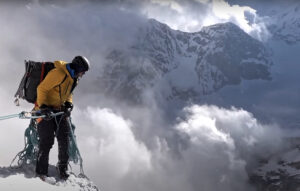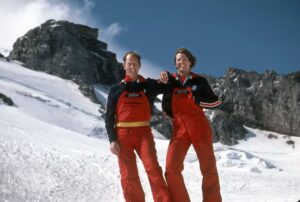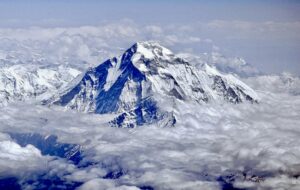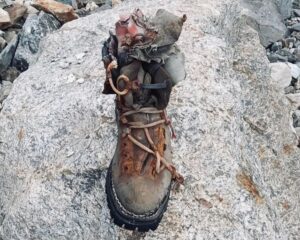John Snorri, Ali Sadpara, and Juan Pablo Mohr have been missing on K2’s upper slopes for over five days, in frigid winter temperatures, amid storms that will continue for some time. And yet, the people supporting the search refuse to call it off.
Helicopters have scanned the mountain for three days on high-risk flights, with the pilots forcing their Lama helicopters beyond their usual altitude roof to a whopping 7,800m. On several occasions, climbers from Base Camp joined them to help search and to shoot photos for later study.
All their efforts have yielded no trace of the missing climbers. “[Perhaps] they have not been found yet because they built an ice cave or shelter,” a press release stated earlier today. “If they had enough fuel to melt water, it could have extended their lifeline, but it depends on how low they made it down on the mountain.”
The document was signed by Ali Sadpara’s friend Rao Ahmad, Sajid Sadpara, and by Vanessa O’Brien, who summited K2 with Snorri in 2014 and acts as a sort of goodwill ambassador in Pakistan.
The document further states that searchers are working with Iceland’s Space Agency to review high-resolution satellite imagery in order to closely analyze the higher elevations of K2 despite the bad weather. They have also obtained data from the devices that the climbers carried: John Snorri’s Thuraya satellite phone, JP Mohr’s Inmarsat, and their Garmin InReach trackers.
It is unknown whether such data have proved useful in any way.
The tracking signals from the InReach devices, for instance, have shown no significant results, according to RaceTracker.
Last tracks’ of John Snorri (green) and JP Mohr (blue) combined on a satellite map of K2. Graph and analysis: RaceTracker.es
English translation of the text in the right-hand sidebar:
Juan Pablo Mohr started the summit push on February 4 at 4:02h from waypoint marked as “Lower C3” at 6,967m. At 10:58h and after gaining 365 vertical metres, he switched his tracker off. Then he switched it on again, with a new signal sent at 11:05h, just some metres away from the previous signal. The device sent two more location points: the last one was sent four minutes later at 7,276m, with batteries at a “Normal” level of charge.
John Snorri set off 30 minutes later than Mohr: at 4:29h from 6,542m. At 14:33h, he passed by 7,298m, nearly at the same point where JP had sent his last signal three and a half hours before. He kept climbing until the last location point sent from his device, at 3:15h on February 5, and at 7,823m high. His InReach registered “Low battery”.
Mountain.ru has shared the SAR satellite images of the mountain. As the site suggests, it’s unlikely that these will help locate the climbers, either.

K2 Bottleneck area (in red) on the SAR satellite images, provided by Iceland’s Space Agency. Shared on Mountain.ru
Finally, the rescue coordination team says that helicopter searches will resume as soon as the weather improves and that Ali Porik of Jasmine Tours is keeping open the Base Camp that he outfitted for John Snorri. There also remain four Pakistani climbers who were reportedly searching every day, until the fierce weather pushed them back to their tents. It is unclear whether any of them is currently in Camp 1.
Meanwhile, the big Seven Summit Treks group has left Base Camp, some by helicopter, others on foot to Skardu, led by Chhang Dawa Sherpa.
In the end, the question remains, whether future efforts made by helicopter pilots and the brave climbers are worth it. As the region’s Minister of Tourism noted yesterday, “it’s also important to accept that their chances of survival are evaporating.”
Nearly everyone who knew and cared for the missing climbers have paid tribute to their memory. The response to Ali Sadpara’s disappearance, in particular, has been overwhelming, not only in Pakistan, where he has become a sort of national hero, but from climbers all around the world.
“Ali knew everyone in Base Camp and was adored by so many,” said John Snorri’s photographer, Elia Saikaly. “Whether dancing at Base Camp, joking around with John and the kitchen staff — his smile, charm, warm heart, sense of humor and kind spirit will always be what defines this great man.”
Many climbers have paid tribute to Ali but few of them are as mournful as Stefi Troguet: “My heart is broken,” she said. “K2 is been ruthless. Ali is one of my favorite souls on earth. He spills his energy on everyone around him. We shared 2×8,000m. He is FAMILY. Losing your altitude family in a couple of weeks is devastating.”
In three weeks, the young, ever-smiling Andorran climber has lost three of her 2019 partners from Nanga Parbat — Ali Sadpara, Sergi Mingote, and Cala Cimenti. Hopefully, she’ll be soon recover her positive energy and direct it into new projects.

Colorful Memories from Nanga Parbat, 2019. Stefi Troguet and Ali Sadpara. Photo: Stefi Troguet
In our Comments section, ExplorersWeb readers have cited a recent interview (in Urdu below) with Pakistani climbing legend Nazir Sabir, who firmly dismisses all false hopes. Some readers were keen enough to translate the highlights of the interview, in an exciting (and highly educated) debate after yesterday’s K2 story.
Below, part of the interview, translated by reader Farukh Ali, in which Sabir discusses the missing climbers.
Q: People are waiting for a miracle right now. What are the survival chances for the whole team?
A: I was interviewed by VOA 3 days ago and I told them very clearly that their chances of survival (provided they haven’t gotten into an avalanche), without activity above 8,000m, is maximum 10 hours. After 10 hours, you will be frozen.
Q: Some of Ali’s relatives are still hopeful that he would be alive. What would you say to that?
A: It’s total madness, and I feel so sorry for the families. If Sajid is saying this, then there’s something wrong with him. We can expect this from someone who has never seen a mountain in his whole life.
In winter, above 8,000m nobody can survive more than 10 hours, even with oxygen. One oxygen cylinder at 2 psi only lasts 15 hours. According to Sajid, they had just one oxygen cylinder.
Q: What are the chances of finding the dead bodies on K2?
A: If they didn’t fall or meet an avalanche, people who climb in summer will probably see their bodies.






